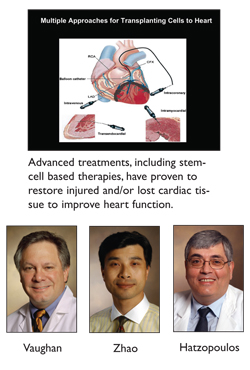
VHVI study probes stem cell timing
In their quest to understand the role of stem cells in restoring cardiac function after a heart attack, Vanderbilt Heart & Vascular Institute researchers are now looking at the role timing plays and whether there is an advantage to delivering cells to the heart sooner rather than later.
“This time question has not been addressed in any other major study in the world ,” said Douglas Vaughan, M.D., director of the Division of Cardiovascular Medicine. “It's important to bring some clarity to that question.”
Vanderbilt is a member of the Cardiac Cell Therapy Research Network, sponsored by the National Heart, Lung and Blood Institute (NHLBI). The network was organized in 2006, in part, to ask new questions about cell therapy.
This Phase II study, called “Time and Late-Time,” will enroll patients in two groups. The first group will receive stem cell therapy within the first few days of their heart attacks. The second group will receive it within three weeks after their heart attacks. Patients will be recruited by the five centers within the network — Vanderbilt, the Cleveland Clinic, the Texas Heart Institute, the University of Minnesota and the University of Florida.
Researchers hope that delivering cells to patients will improve their heart function after a heart attack, but there is not a lot of information available about the value of cell therapy more than a week or so out, Vaughan said.
“All of the clinical trials that have been done so far have enrolled patients within three to seven days,” Vaughan said. “So I think it's important to try to understand if there is something different about the environment of the heart immediately after a heart attack that makes it more receptive or more likely to respond to cells.
“Or, will we have the luxury of time and be able to provide cell therapy weeks after someone's heart has been damaged?”
Cell death occurs immediately after a heart attack due to the loss of the myocytes that make up the heart muscle. Late-time will test the hypothesis that cell therapy might reverse late defects like fibrosis and tissue remodeling.
Since this phase can take weeks or months, there is a window of opportunity in both the short term and long term to see a beneficial effect of cell therapy.
“Patients appear to be stable initially, but they may develop congestive heart failure in a few months,” said David Zhao, M.D., director of the Cardiac Catheterization Laboratory and Interventional Cardiology. “Giving stem cells to infarcted hearts may help to regenerate muscle cells that will prevent heart failure.”
In addition, the delayed cell delivery time holds the potential for extending cell-based therapies to a broader population, said Antonis Hatzopoulos, Ph.D., associate professor of Medicine.
“Specifically, it will permit patient transfer to tertiary sites for cell delivery and inclusion of sicker patients with cardiogenic shock who would be too ill to receive cell therapy soon after a heart attack,” he said.
A person who elects to participate in the trial will undergo a bone marrow aspiration, which is done under local anesthesia. The cells are removed, filtered and processed to concentrate endothelial progenitor cells.
The cells are then infused via a catheter directly into the coronary artery during the patient's return visit to the cath lab.
Using echocardiography and cardiac MRI, researchers will obtain baseline and follow-up measures of the patient's heart structure and function to see how the cell therapy has impacted cardiac function.
“We've had this dogma in the cardiovascular world that we have a limited number of cells in our heart, and if we lose them, that's it,” Vaughan said.
“The idea that we might be able to regenerate or repopulate the heart with cells that can actually improve heart function is tremendously exciting.
“It's a whole new way of treating patients. It's something that's never been feasible before, let alone conceivable.”













